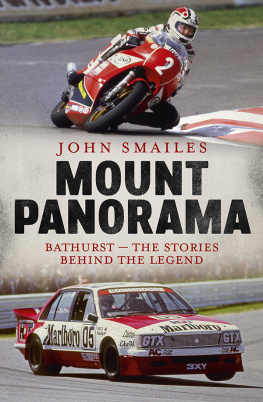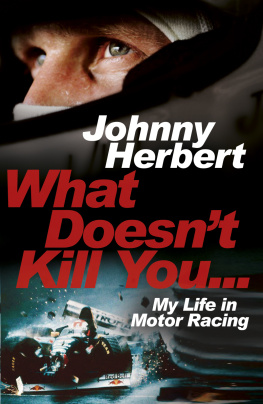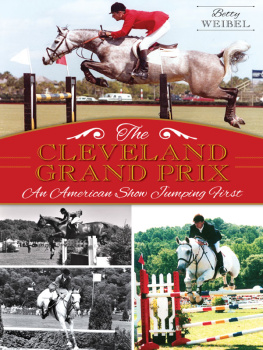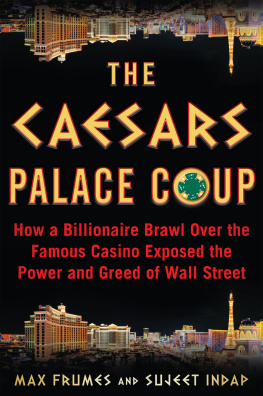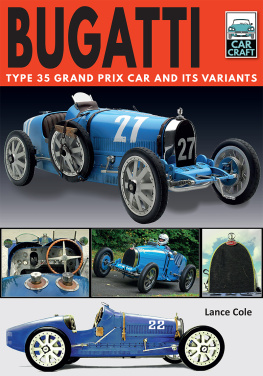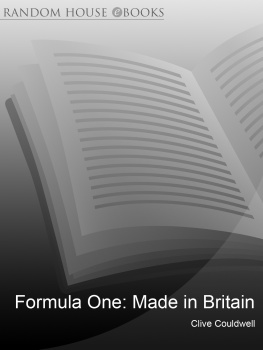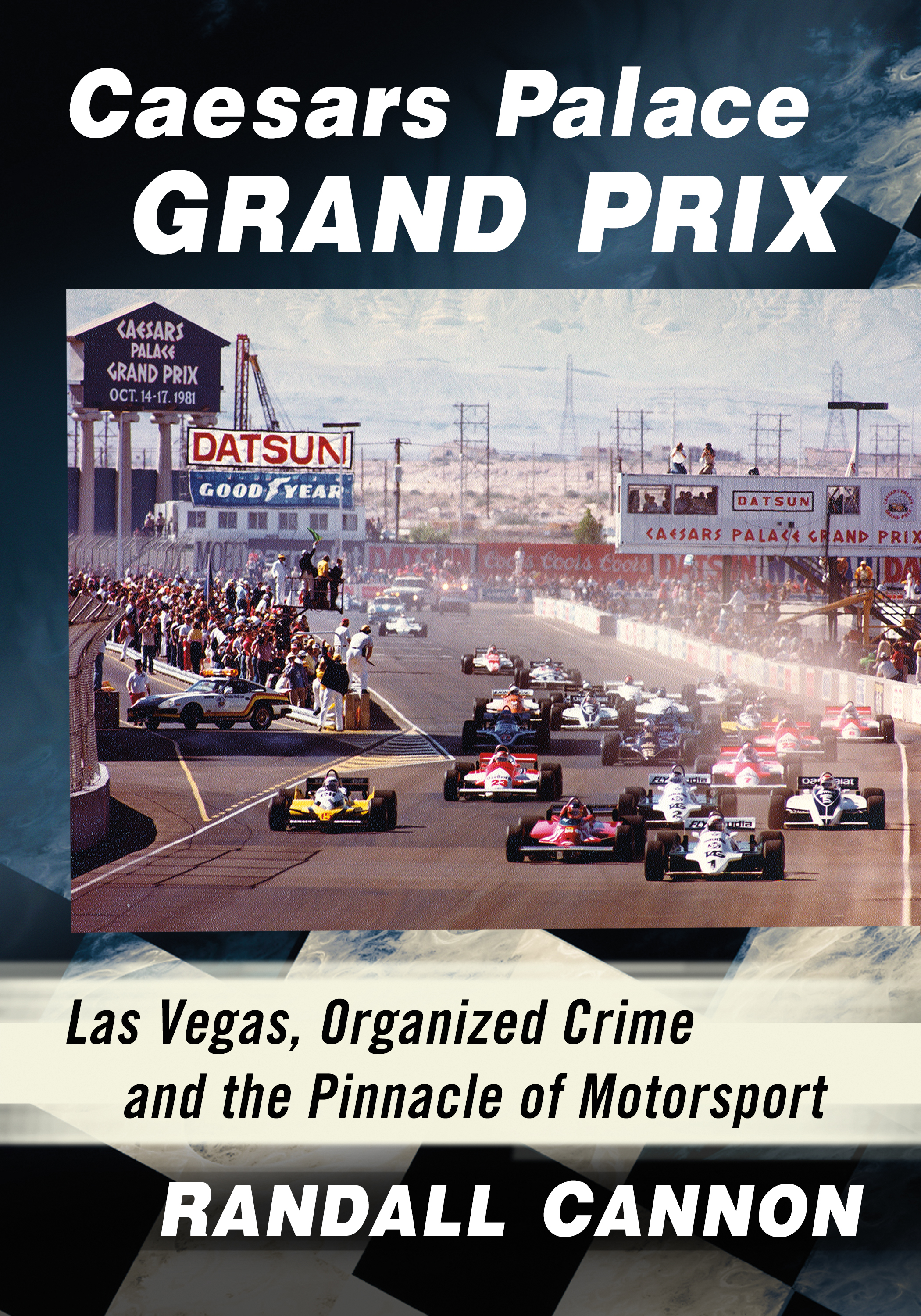Caesars Palace Grand Prix
Also by Randall Cannon and Michael Gerry
Stardust International Raceway: Motorsports Meets the Mob in Vegas, 19651971 (McFarland, 2018)
Caesars Palace Grand Prix
Las Vegas, Organized Crime and the Pinnacle of Motorsport
Randall Cannon

Library of Congress Cataloguing-in-Publication Data
Names: Cannon, Randall, 1956 author.
Title: Caesars Palace Grand Prix : Las Vegas, organized crime and the pinnacle of motorsport / Randall Cannon.
Description: Jefferson, North Carolina : McFarland & Company, Inc., Publishers, 2021
Includes bibliographical references and index.
Identifiers: LCCN 2021032518 | ISBN 9781476683775 (paperback : acid free paper)
ISBN 9781476642826 (ebook)
Subjects: LCSH: Caesars Palace Grand Prix (Automobile race) | GamblingNevadaLas Vegas. | Organized crimeNevadaLas Vegas. | Automobile racingNevadaLas Vegas. | BISAC: SPORTS & RECREATION / Motor Sports / General | HISTORY / United States / State & Local / West (AK, CA, CO, HI, ID, MT, NV, UT, WY)
Classification: LCC GV1033.5.C34 C36 2021 | DDC 796.7209793/135dc23
LC record available at https://lccn.loc.gov/2021032518
British Library cataloguing data are available
ISBN (print) 978-1-4766-8377-5
ISBN (ebook) 978-1-4766-4282-6
2021 Randall Cannon. All rights reserved
No part of this book may be reproduced or transmitted in any form or by any means, electronic or mechanical, including photocopying or recording, or by any information storage and retrieval system, without permission in writing from the publisher.
Front cover: The Formula One field of the Caesars Palace Grand Prix takes the green flag at the start of the race on October 17, 1981, in Las Vegas, Nevada (William D. Weinberger Collection)
Printed in the United States of America

McFarland & Company, Inc., Publishers
Box 611, Jefferson, North Carolina 28640
www.mcfarlandpub.com
To Jimmy, Spunki, and Reina
Table of Contents
Acknowledgments
The Caesars Palace Grand Prix presented a fascinating opportunity to study two parallel threads of history, the progression of Formula One motorsport through America and forward to Caesars Palace, alongside the influences of the national crime syndicate and the development and operational plan for Caesars Palace. As such, the body of research traverses several decades. This is a story, then, that could not have been told without the willing recollections of the participants and observers populating both paths through the past. Photographic contributions, as well, brought the story to a vivid reality. The author acknowledges the contributions of the following for the generosity of their time, their remembrances, and their resources, with deepest gratitude.
Most of all, I express my heartfelt appreciation to my patient, supportive, loving wife Julie. Further, this work would not be possible without the constant encouragement and wisdom of our children, Courtney, Camille, and Clark.
Former Caesars Palace Vice President of Casino Marketing William D. Weinberger provided invaluable insight into the origins of the Caesars Palace Grand Prix as well as a peek inside the Palace of Caesar. Mr. Weinberger also provided several images from his personal collection.
Former Caesars World, Inc. legal counsel and Caesars Palace Vice President Bruce Aguilera steered the Caesars Palace Grand Prix storyline through the transition from Formula One to the CART IndyCar series, as well as provided background on the Caesars Palace chief executive and later Formula One efforts in Las Vegas. Mr. Aguilera also facilitated access to Caesars Palace Grand Prix press materials, race programs, and race posters.
Friends and colleagues who contributed selflessly to the success of the project: Josh Ashby/International Motor Racing Research Center, Mike Follmer, Rick Lake, Tony Landis, Scott Liles, Mike Machat, Marc Nelson, Ernie Ohlson, and Pete Ward.
The racers, journalists, broadcasters, archivists, historians, photographers, and other contributors to the history of the Caesars Palace Grand Prix, Caesars Palace, Formula One in America, and this story, in alphabetical order: Jenny Ambrose/International Motor Racing Research Center, Mario Andretti, Duke Argetsinger/International Motor Racing Research Center, Allen Brown/Oldracingcars.com, Jeff Burbank, Su Kim Chung, Ph.D./University of NevadaLas Vegas, Allan Coy/California Sports Car Club, Wally Dallenbach, Jr., Jay Dalton, Tom Daniel, Gary Gerould, Bill Green/International Motor Racing Research Center, Michael Green, Ph.D./University of NevadaLas Vegas, Mike Henle, Bethany Khan/Culinary Workers Union Local 226, Las Vegas News Bureau, Jack Long, Pete Lyons, Jane Tyler Maners/Caesars Entertainment, Anthony Marnell/Marnell Companies, Brent Martin, Jim Michaelian/Grand Prix Association of Long Beach, Robin Miller/Racer.com, Jeff Motley/Las Vegas Motor Speedway, Mary Lou Pernicano/Penske Corporation, Chris Pook, Revs Institute for Automotive Research, Lyn St. James, Jay Sarno, Jr., David G. Schwartz, Ph.D./University of NevadaLas Vegas, Tony Scodwell, Jeffrey A. Silver/Dickinson-Wright, John L. Smith, Stuart Sobek/Las Vegas Concours de Elegance, Sir Jackie Stewart, John Surtees, Jeff Teasley/HistoricAerials.com, Rick Titus, Al Unser, Bobby Unser, Tina Van Curen/Autobooks-Aerobooks.com.
Preface
FORMULA ONEthe undisputed pinnacle of professional motorsport. For more than 70 years, Formula One has represented the highest level of technology, achievement, and spectacle in motor racing. The Formula One World Drivers Championship was first awarded in 1950. Luminary international names such as Juan Manuel Fangio, Alberto Ascari, Jack Brabham, Jimmy Clark, Graham Hill, John Surtees, Jackie Stewart, Nelson Piquet, Alain Prost, Ayrton Senna, Sebastian Vettel, Lewis Hamilton, and the incomparable Michael Schumacher have made their indelible mark on the championship. America, too, has produced Formula One champions, Phil Hill in 1961 and Mario Andretti in 1978.
Formula One has also forged a reputation of political maneuvering, incessant meddling, and extreme profiteering. The premier event of the Formula One series is certainly the Grand Prix of Monaco, renowned for its stunning display of wealth, celebrity, and high-stakes gambling. Formula One, however, also counts its casualties; 47 sobering fatalities have been recorded among its combatants. With its contrast, then, of Monaco and mortality, Formula One could be regarded as the ultimate game of chance. It might also be inevitable, then, that Formula One would develop a special relationship with Las Vegas, the undisputed gambling, hospitality, and entertainment capital of the world.
Formula One first sampled American soil in 1959 at Sebring, Florida, and in 1960 at Riverside International Raceway. The international racing series then found long-term American homes at Watkins Glen, New York, and Long Beach, California. The path to the Caesars Palace Grand Prix, however, would run through the American power-centers of organized crime, shadowy dealings, and political intrigues. In that regard, Formula One may have found the perfect partner in Las Vegas and Caesars Palace, each entity steeped in secrets to present its own lavishly constructed image.


